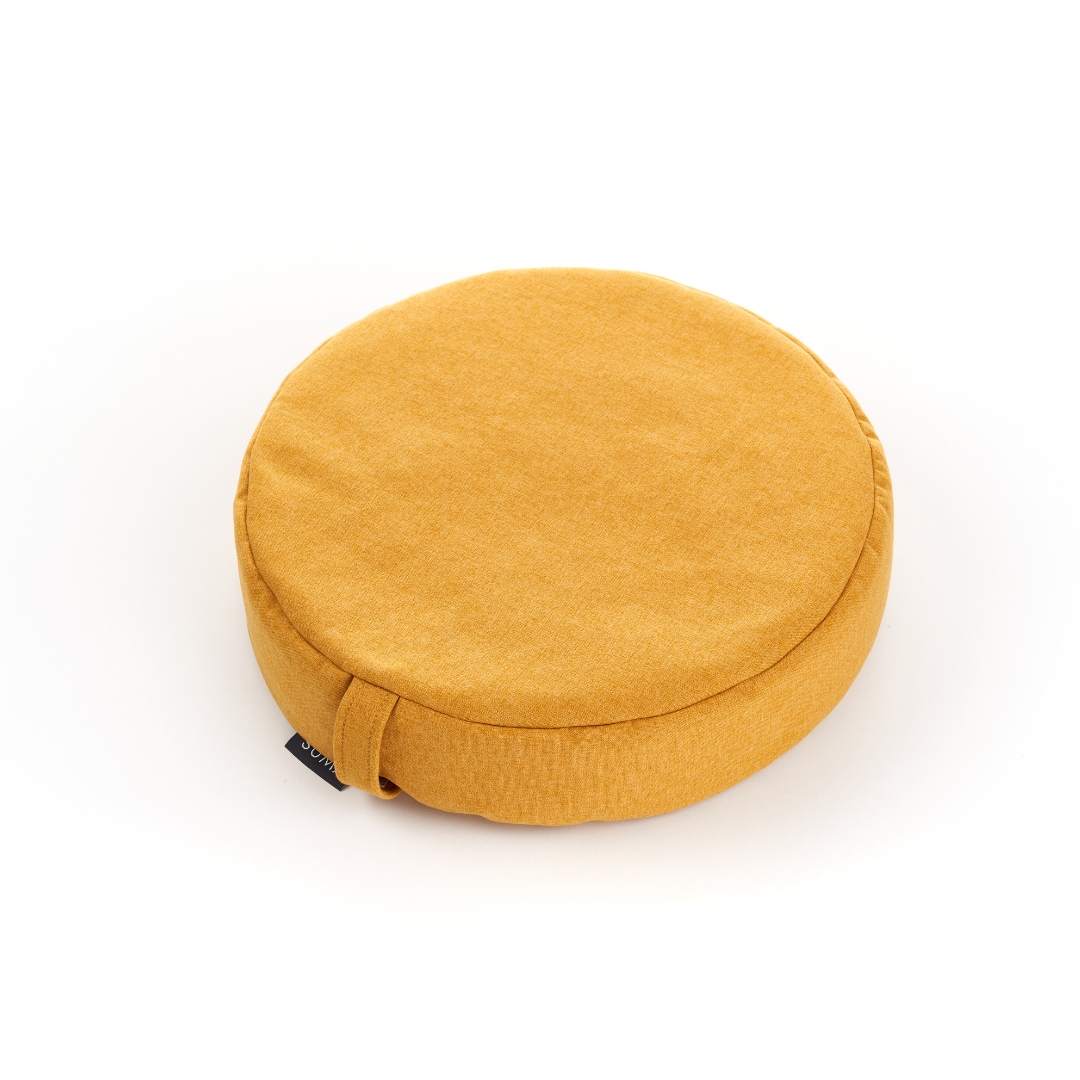Meditation is a powerful way to achieve peace, clarity, and calmness in your busy life. But with so many different types of meditation, how do you choose the right one for you?
You may feel overwhelmed by the options and wonder which suits your personality, goals, and preferences.
In this article, you will discover different types of meditation for beginners and how to overcome common challenges during practice.
Types of meditation
Given are just a few of the many different types of meditation for beginners.
1. Breathing meditation

Breathing meditation effectively calms your mind and body by focusing on your natural breathing rhythm. It is also known as pranayama, Anapanasati, diaphragmatic breathing, deep breathing, and breath awareness meditation.
Origin
The earliest written records of breathing meditation come from the Hindu Vedas.
When to do it
It is helpful when you feel overwhelmed, anxious, or distracted by life’s challenges.
How to do it
- Find a quiet and comfortable place to sit without being disturbed.
- You can sit on a chair, a cushion, or the floor as long as you keep your back straight and relaxed.
- Shut down notifications on your mobile. Set a timer for how long you want to meditate.
- You can start with 10 minutes and gradually increase the duration as you become more proficient with the practice. Close your eyes and bring your attention to your breathing. Notice how it feels in your nose, chest, and belly.
- You don’t need to change or control your breath. Just observe it as it is.
- As you meditate, you will also notice other sensations, thoughts, and emotions that arise in your mind and body.
- Instead of judging, resisting, or reacting to them, simply acknowledge them and let them be.
- Then, gently bring your attention back to your breathing. Repeat this process until the timer goes off. Then, slowly open your eyes and take a moment to appreciate your experience.
Next step
You can check out this breathing meditation video to learn more about breathing meditation.
2. Mindfulness meditation

Mindfulness meditation is a practice of cultivating awareness and acceptance of the present moment. It is also known as vipassana, insight meditation, sati, zen meditation, and present moment awareness. It can help you develop a more balanced and compassionate perspective on yourself and your life.
Origin
Mindfulness meditation derives from Hindu and Buddhist traditions.
When to do it
You can practice mindfulness meditation at any time of the day, but it may be easier to do it in the morning or evening when you are less likely to be interrupted.
Practicing mindfulness meditation before or after a stressful event, such as a meeting, a presentation, or a difficult conversation, can also be beneficial.
How to do it
- Find a quiet and comfortable place to sit without being disturbed. You can sit on a chair, a cushion, or the floor as long as you keep your back straight and relaxed.
- Shut down notifications on your mobile.
- Set a timer for how long you want to meditate. You can start with 5 minutes and gradually increase the duration as you become more comfortable with the practice.
- Close your eyes and bring your attention to your breathing. Notice how it feels in your nose, chest, and belly. You don’t need to change or control your breath. Just observe it as it is.
- As you meditate, you will notice that your mind will wander to different thoughts, feelings, sensations, or sounds. This is normal and natural. Don’t try to stop or suppress them; just acknowledge them and let them go. Then, gently bring your attention back to your breathing.
- Repeat this process until the timer goes off. Then, slowly open your eyes and take a moment to appreciate your feelings.
Next step
You can check out this mindfulness video to learn more about mindfulness meditation.
3. Transcendental meditation

Transcendental meditation is a silent mantra meditation developed by Maharishi Mahesh Yogi. It involves using a personalized mantra to achieve a state of deep relaxation and awareness. It is also known as TM, mantra, silent, and Maharishi meditation.
Origin
It is based on India's ancient Vedic enlightenment tradition.
When to do it
You can practice transcendental meditation to lower your blood pressure, reduce stress and anxiety, improve brain function and memory, enhance mood and well-being, and increase self-esteem and self-actualization. You can also practice it to experience a state of pure awareness, where you feel inner peace, happiness, and creativity.
How to do it
- To do it, you need to learn the technique from a certified TM teacher who will assign you a suitable mantra, a sound, or a word with no meaning.
- The mantra is repeated silently in the mind for 15 to 20 minutes twice a day, preferably in the morning and evening.
- The purpose of the mantra is to help the mind transcend the surface level of consciousness and reach a state of pure awareness.
Next step
To learn more about transcendental meditation, you can check out this video introduction to transcendental meditation by Bob Roth.
4. Loving-kindness meditation

Loving-kindness meditation cultivates compassion, kindness, and warmth toward yourself and others. It is also known as Metta meditation, compassion meditation, heart meditation, and Maitri meditation.
It is based on the Buddhist concept of Metta, which means benevolence, friendliness, and goodwill. During this practice, you repeat positive phrases or wishes to yourself, loved ones, strangers, and enemies.
Origin
It originates from Buddhist traditions.
When to do it
You can practice loving-kindness meditation to reduce stress, anxiety, depression, anger, and pain. It can also increase your happiness, satisfaction, gratitude, and empathy. It can help you resolve conflicts and develop empathy, goodwill, and forgiveness toward all healthy beings.
According to Hofmann et al. (2011), loving-kindness meditation (LKM) and compassion meditation (CM) activate the brain areas responsible for emotional processing and empathy. These meditation types aim to enhance positive emotional states of kindness and compassion towards oneself and others. When these meditation techniques are combined with cognitive-behavioral therapy, they may help overcome psychological problems that involve interpersonal processes, such as depression, social anxiety, marital conflict, anger, and coping with the strains of long-term caregiving.
How to do it:
- Find a quiet and comfortable place, and set a timer for how long you want to meditate.
- Close your eyes and bring your attention to your heart center. Feel the warmth and love in your chest. You can also place your hand over your heart if you like.
- Start by repeating a phrase of kindness towards yourself, such as “May I be happy, healthy, and peaceful.” Feel the meaning of the words in your heart. You can also use other phrases that resonate with you.
- Then, extend the exact phrase to someone you love, such as a family member or a friend. Imagine them in front of you and feel the love and connection between you. Say, “May you be happy, healthy, and peaceful.”
- Next, extend the phrase to someone you are neutral about, such as a coworker or a neighbor. Try to feel some warmth and kindness towards them. Say, “May you be happy, healthy, and peaceful.”
- Then, extend the phrase to someone you have difficulty with, such as an enemy or a rival. This may be challenging, but try to overcome your resentment or anger towards them. Wish them well and say, “May you be happy, healthy, and peaceful.”
- Finally, extend the phrase to all beings, including animals, plants, and even yourself. Feel the compassion and goodwill that radiates from your heart. Say, “May all beings be happy, healthy, and peaceful.”
- Repeat this process until the timer goes off. Then, slowly open your eyes and take a moment to appreciate your feelings.
Next step:
To learn more about loving-kindness meditation, you can check out this article from HeadSpace.
5. Body scan meditation

Body scan meditation focuses on different parts of your body and notices the sensations, feelings, and emotions that arise.
It is also known as progressive relaxation, mindful body scanning, somatic meditation, and body awareness meditation.
It is a way of cultivating awareness, relaxation, and acceptance of your physical and mental state.
Origin
It is often associated with Jon Kabat-Zinn’s Mindfulness-Based Stress Reduction (MBSR) program, which he introduced to the United States in the 1970s.
When to do it
You can practice body scan meditation to relieve stress, tension, pain, or discomfort in your body. It can also help you to improve your mood, sleep quality, and well-being. You can do it before going to bed, after waking up, or anytime you need a break from your busy day.
The research was conducted in 2012 by Michael Usshar to investigate the impact of body scan meditation on chronic pain symptoms. For this study, 50 participants were divided into two groups randomly. One group did the body scan meditation, whereas the control group listened to simple reading about natural history. The results showed that the participants who engaged in body scans twice daily for 10 minutes reported a significant reduction in pain-related distress as compared to the control group.
How to do it:
- Find a quiet and comfortable place to sit or lie down without being disturbed. You can use a chair, a bed, a cushion, or the floor as long as you feel relaxed and supported.
- Set a timer for how long you want to meditate. You can start with 10 minutes and gradually increase the duration as you become more comfortable with the practice.
- Close your eyes and bring your attention to your breathing. Notice how it feels in your nose, chest, and belly. You don’t need to change or control your breath; just observe it as it is.
- Start by scanning your body from head to toe or from toe to head, depending on your preference. You can either move through each body part one by one or focus on larger areas such as the legs, the arms, the torso, etc.
- As you scan each body part, notice the sensations there. They could be pleasant, unpleasant, or neutral. They could be warm, cold, tingling, numb, tight, loose, etc. Don’t judge or analyze them; just acknowledge them and let them be.
- If you encounter any pain or discomfort in any body part, don’t try to avoid or resist it. Instead, breathe into it and send kindness and compassion to that area. You can also use phrases such as “May this pain be eased” or “May this area be healed.”
- If you notice any thoughts or emotions that arise during the scan, don’t get caught up in them. Just observe them as they are and let them go. Then, gently bring your attention back to your body scan.
- Repeat this process until you have scanned your whole body. Then, take a moment to appreciate how you feel and thank yourself for taking the time to meditate.
Next step:
If you want to learn more about body scan meditation, you can check out this guide by Mindful.
The most common challenges people report with meditation
Most people find it hard to maintain a regular meditation practice. Here are the common meditation challenges:
- Difficulty staying focused
Staying focused is the prime challenge to meditation because our minds are often occupied with thoughts and worries. Remember that wandering of mind is entirely normal, but it will get better with regular practice. If you remain consistent, you will learn to redirect your attention to the present moment, improving focus and concentration.
- Lack of discipline
What we often refer to as discipline is a habit. Because being disciplined once is not a thing. Habits rule our world and become second nature to us. But how do you cultivate a habit out of meditation?
- Make it as easy for yourself as possible - find a comfortable spot in your household or workplace. Then, find a time that does not need a personal sacrifice (e.g., after lunch in the office in an empty meeting room).
- Keep it short. Start with 5 minutes and only increase the time when you feel ready.
- Stick to your practice daily for 3 weeks. This is way more important than the duration.
- Make it enjoyable for yourself :) Reward yourself for keeping the routine. Or find friends to do a 3-week challenge with.
Making meditation a habit will pay off throughout your lifetime. And you will feel the effects every day.
- Time constraints
Due to busy schedules, most people find it hard to devote time to meditation. Sticking to a constant routine instead of worrying about duration is key. Even a few minutes of meditation daily can make a huge difference.
Start by finding time in your day when no one expects anything from you. It doesn't matter if it's early in the morning, lunchtime, or later in the evening.
Set aside 5 minutes, avoid distractions, switch off your phone, and dedicate this time to meditation. If you meditate daily, you will develop a proper routine over time and reap the benefits.
- Falling asleep
Falling asleep during meditation is a common challenge that many practitioners face. However, it is not an insurmountable obstacle. With some tips and guidance, you can overcome it and enjoy the benefits of meditation. First of all, you need to understand why you fall asleep during meditation.
Feeling drowsy when your body is relaxed and your mind is calm is natural. This can happen, especially if you are tired or sleep-deprived.
There are many ways to keep yourself awake:
Choose the right time. Avoid meditating when you are too sleepy or too full. The best time to meditate is when you are fresh and alert, such as in the morning or after a light meal.
Maintain a good posture. Sit upright and comfortably, with your spine straight and your head balanced. This will help you breathe better and keep your energy flowing. Avoid lying down or reclining, as these positions can induce sleepiness.
Engage in active meditation. Instead of just observing your breath, you can try to focus on a mantra, a sound, a visualization, or a physical sensation. These techniques help keep your mind engaged and interested in meditation.
Explore various techniques. There are many types of meditation, such as mindfulness, transcendental, etc. Each one has its benefits and challenges. You can experiment with different techniques and find the one that suits you best. Falling asleep during meditation is nothing to feel bad about. It means that you need rest. However, if it happens too often, it may indicate that you need to get enough sleep or that you need to follow the proper instructions for meditation.
- Boredom
Boredom is a common challenge many people face when trying to meditate. It may seem like meditation is boring because it involves sitting still in complete silence, without any distractions or entertainment. However, boredom is not a sign that meditation is not working or that you are doing it wrong. Boredom is a sign that your mind is restless and craving stimulation. It is a natural reaction to the contrast between your usual busy and noisy life and meditation's calm and quiet state.
Boredom is also an opportunity to grow and learn. It can teach you patience, acceptance, and gratitude. Instead of resisting or avoiding boredom, you can embrace it and explore it with curiosity. You can use boredom as a way to deepen your awareness of yourself and your surroundings. You can also use boredom as a motivation to practice more consistently and diligently.
There are some ways to deal with boredom during meditation. Some of them are:
Remind yourself of your intention. Why do you meditate? What do you hope to achieve? How does meditation benefit you? By remembering your purpose and motivation, you can rekindle your enthusiasm and commitment.
Notice the subtle changes. Meditation is not a static or monotonous activity. It is a dynamic and rich experience. Every breath, every sensation, every thought is different and unique. If you pay attention to the subtle changes in your body and mind, you will discover new insights and perspectives.
Challenge yourself. Meditation is not a competition or a performance. It is a practice and a skill. You can always improve and challenge yourself by setting goals and tracking your progress. For example, you can try to meditate for longer periods, in different environments, or with different techniques.
Takeaway
Meditation practice can be performed with different techniques, each offering its unique approach to inner calmness. Try meditating with multiple techniques to overcome common meditation challenges and determine which one keeps your mind focused.
One of the common challenges that beginners face is finding a comfortable and supportive posture for meditation. That’s why it is recommended to use a meditation cushion that can help you sit with ease and alignment.

A meditation cushion can also make your meditation space more inviting and cozy, so you can meditate anywhere you want. If you are interested in buying a high-quality meditation cushion that is durable, eco-friendly, and stylish, check out SUMA. They have a variety of colors and sizes to suit your preferences and needs.










Leave a comment
All comments are moderated before being published.
This site is protected by hCaptcha and the hCaptcha Privacy Policy and Terms of Service apply.